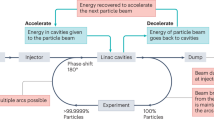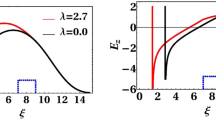Abstract
The linear accelerator principle as used in the Sloan and Lawrence positive ion accelerator1 has received a new stimulus from the advent of radar magnetrons giving high peak powers under pulse operation at short wave-lengths. These new techniques are particularly suitable for the acceleration of electrons, since their velocity may easily be made comparable, even at injection, with the velocity of propagation of electromagnetic waves. It therefore becomes practicable to accelerate electrons continuously by carrying them in tight bunches around a stable position in a travelling radio-frequency wave.
This is a preview of subscription content, access via your institution
Access options
Subscribe to this journal
Receive 51 print issues and online access
$199.00 per year
only $3.90 per issue
Buy this article
- Purchase on Springer Link
- Instant access to full article PDF
Prices may be subject to local taxes which are calculated during checkout
Similar content being viewed by others
References
Sloan, D. H., and Lawrence, E. O., Phys. Rev., 38, 2021 (1931).
Cutler, C. C., Bell Tel. Lab., MM/44/160/218.
Radio Research Laboratory, Harvard University, Cambridge, Mass. Confidential Report No. RRL411-229. Much assistance in constructing the load was also obtained from a set of working drawings kindly supplied by the Radio Research Laboratory.
Author information
Authors and Affiliations
Rights and permissions
About this article
Cite this article
FRY, D., R.-S.-HARVIE, R., MULLETT, L. et al. Travelling-Wave Linear Accelerator for Electrons. Nature 160, 351–353 (1947). https://doi.org/10.1038/160351a0
Issue Date:
DOI: https://doi.org/10.1038/160351a0
This article is cited by
-
Radiation oncology: a century of achievements
Nature Reviews Cancer (2004)
-
4.5-Mev linear electron accelerator
The Soviet Journal of Atomic Energy (1957)
-
The New Megavoltage Radiotherapy Unit at Manchester
Nature (1955)
-
Letters to Editor
Nature (1949)
-
A Method of Feeding Micro-wave Power into a Resonator having a Fine Mode Structure
Nature (1948)
Comments
By submitting a comment you agree to abide by our Terms and Community Guidelines. If you find something abusive or that does not comply with our terms or guidelines please flag it as inappropriate.



